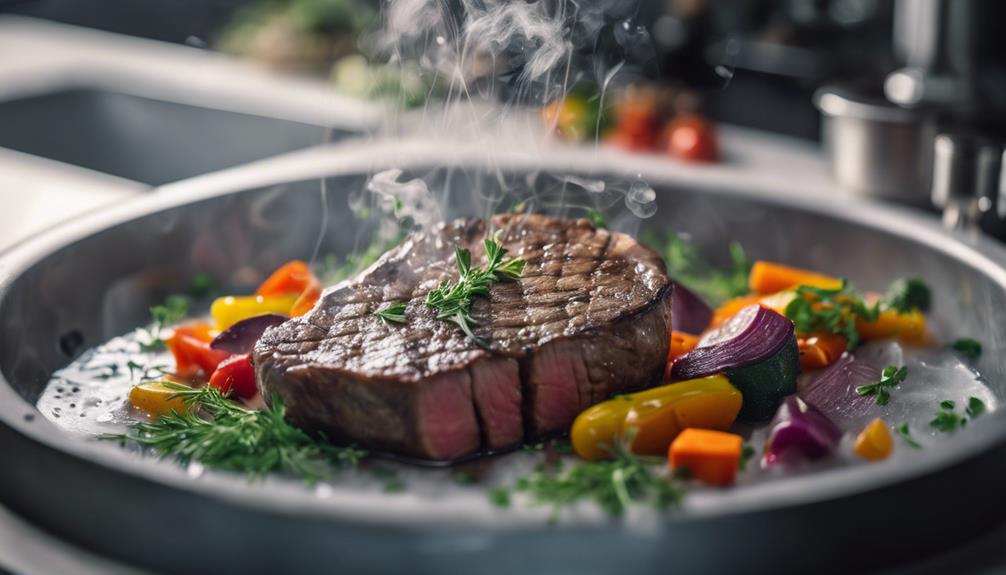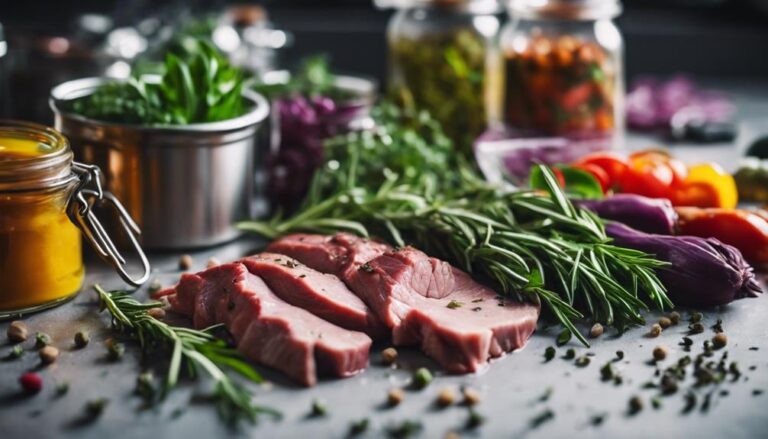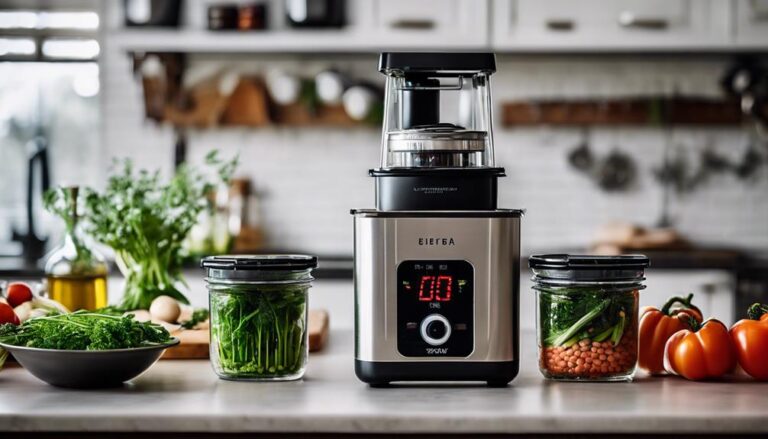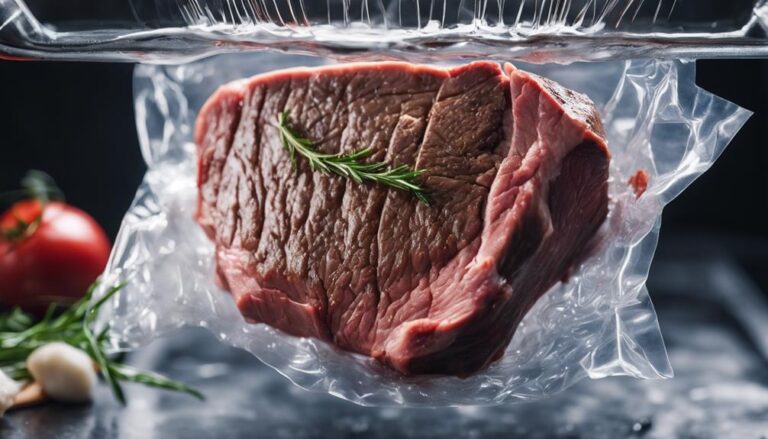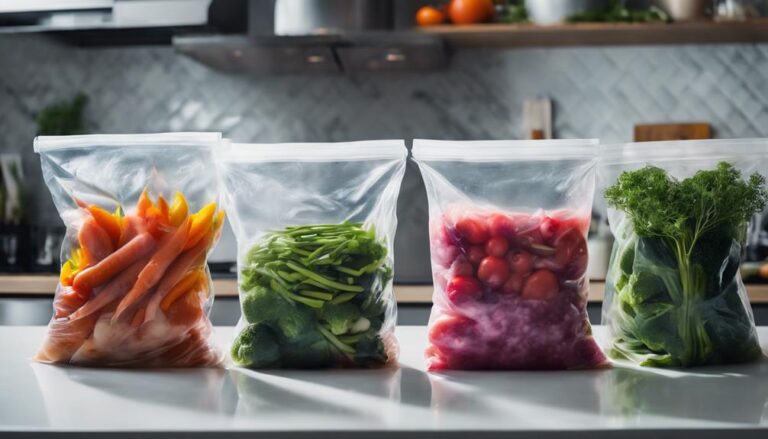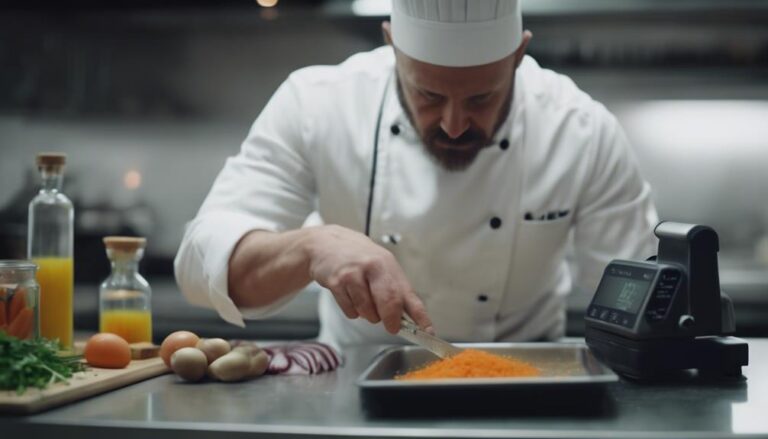Maintaining Nutrient Density With Sous Vide Cooking
Sous vide cooking is a great way to maintain nutrient density in your meals. By cooking at low temperatures, typically between 55°C and 95°C, you minimize nutrient loss while enhancing protein digestibility and retaining essential vitamins and minerals. This method preserves moisture and flavor without added fats, making your dishes both healthy and delicious. Using nutrient-dense ingredients, like lean meats and fresh vegetables, further boosts health benefits. Plus, vacuum sealing minimizes evaporation and guarantees even cooking. If you explore more about sous vide, you'll discover specific cooking times and flavors that optimize your meal's nutritional value.
What You Will Learn Here
- Sous vide cooking retains up to 90% of water-soluble vitamins, enhancing nutrient preservation compared to traditional methods.
- Precise temperature control minimizes nutrient loss, improving protein digestibility and mineral bioaccessibility.
- Vacuum sealing prevents moisture loss and lipid oxidation, preserving antioxidants and flavors in food.
- Cooking at low temperatures for extended periods maximizes tenderness while retaining essential vitamins and minerals.
Understanding Sous Vide Cooking
Sous vide cooking, with its precise temperature control and vacuum-sealing technique, allows you to achieve perfectly cooked meals while preserving their natural flavors and nutrients.
This innovative method involves cooking food in a water bath at controlled temperatures, typically ranging from 55°C to 95°C. By utilizing low-temperature long-time cooking, you minimize nutrient loss, ensuring that essential vitamins and minerals remain intact.
One of the key benefits of sous vide cooking is its ability to enhance the digestibility of proteins. The gentle cooking process improves the bioaccessibility of minerals, making them easier for your body to absorb.
Additionally, this method effectively retains moisture and flavor, resulting in a more enjoyable eating experience. Unlike traditional cooking methods that can create harmful compounds or lead to lipid oxidation, sous vide minimizes these risks, promoting a healthier alternative.
Nutritional Benefits of Sous Vide
Cooking with sous vide offers numerous nutritional benefits, ensuring that your meals aren't only delicious but also packed with essential vitamins and minerals. This innovative cooking method excels in nutrient retention, particularly for sensitive vitamins like B and C, making it an excellent choice for health-conscious individuals.
Here are some key advantages of sous vide cooking:
- Enhanced protein digestibility, allowing your body to absorb essential amino acids more effectively.
- Improved retention of minerals such as calcium, iron, and magnesium, ensuring you get the most out of your meals.
- Minimized lipid oxidation, which helps preserve the antioxidant properties of your food, contributing to overall nutritional quality.
Key Ingredients for Nutrient Density
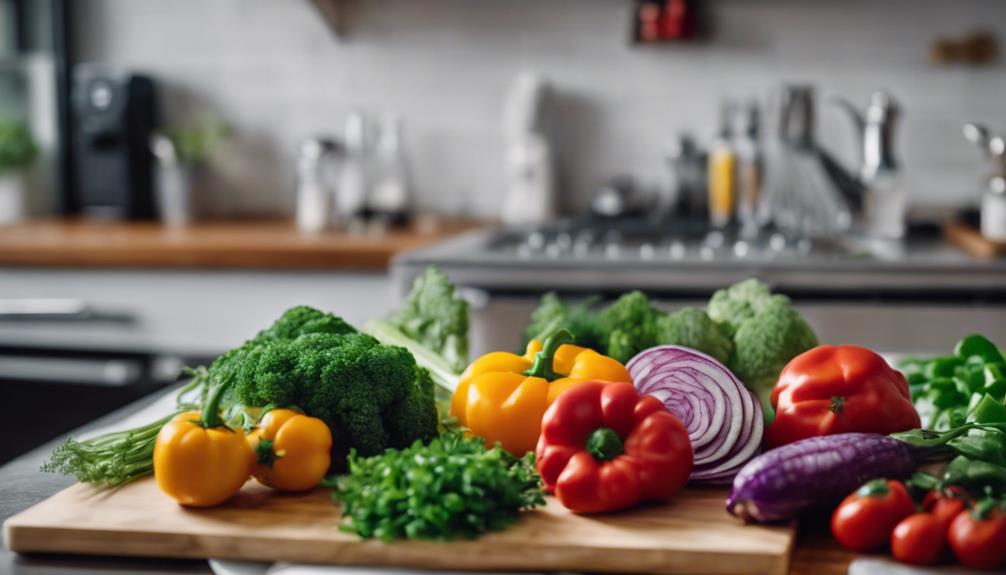
Selecting the right ingredients is key to maximizing nutrient density in your sous vide meals, allowing you to benefit from the full range of vitamins and minerals.
When choosing proteins, lean meats like chicken breast and pork tenderloin are excellent options. Sous vide cooking preserves their protein content while ensuring moisture retention, making them tender and flavorful without excess calories.
For seafood lovers, salmon is a standout ingredient. Cooking it sous vide retains omega-3 fatty acids, essential for heart and brain health, while enhancing its natural flavors without added fats.
Don't forget about vegetables, which can be nutritional powerhouses. Sous vide cooking helps retain valuable phytochemicals and antioxidants, providing a greater health boost than traditional boiling methods that leach nutrients into the cooking water.
Lastly, consider sous vide poached eggs for a nutrient-dense breakfast. They maintain high protein content and choline levels, all without the need for added fats or salts that can diminish their benefits.
Comparing Cooking Methods
When you compare various cooking methods, sous vide stands out for its ability to preserve nutrients and enhance flavors while minimizing harmful compounds. The sous vide method offers distinct advantages over traditional cooking methods, especially when it comes to maintaining the nutritional value of meat.
- Retains up to 90% of water-soluble vitamins like B vitamins
- Reduces lipid oxidation, preserving antioxidants
- Enhances the bioaccessibility of minerals such as calcium and iron
By employing low temperature-long time (LT-LT) heat treatments, sous vide cooking reduces the risk of nutrient loss that often occurs with boiling or frying. Traditional methods can leach valuable nutrients into cooking water, while the vacuum-sealing process maintains moisture retention without added fats.
This innovative approach not only keeps your food safe but also guarantees that you get the most out of every bite. You'll enjoy flavorful, nutrient-rich meals that are hard to achieve through conventional techniques.
Embracing sous vide means prioritizing your health and culinary experience while steering clear of the drawbacks associated with traditional cooking methods.
Health Implications of Sous Vide
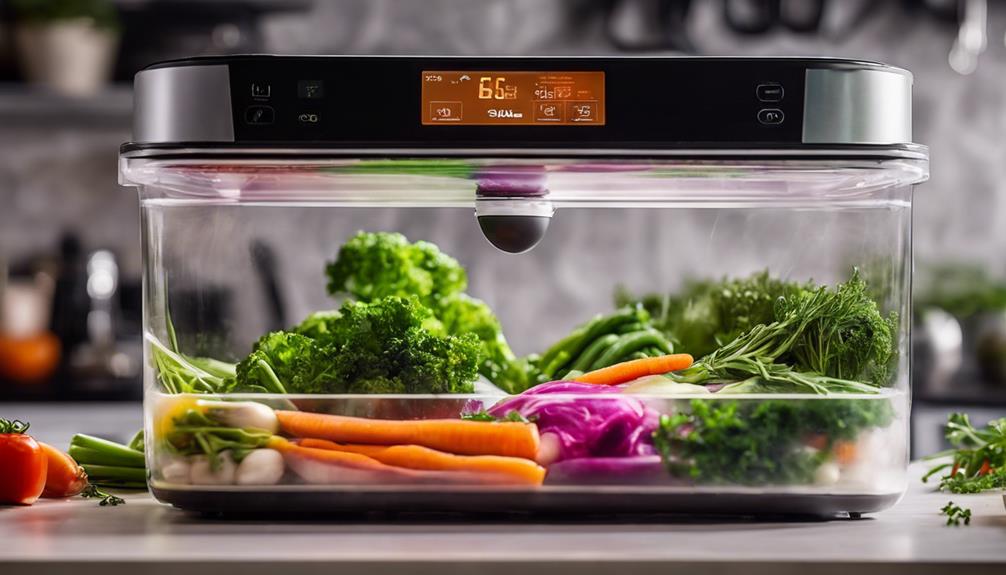
Embracing sous vide can greatly enhance your nutrient intake while reducing the risk of harmful compounds often associated with higher-temperature cooking methods. This innovative approach to cooking preserves essential vitamins and minerals more effectively than traditional methods, leading to impressive nutrient retention, especially for water-soluble vitamins like B and C.
By utilizing controlled temperature, sous vide cooking minimizes lipid oxidation and enhances protein digestibility, allowing you to enjoy meals with improved nutrient density.
Moreover, studies indicate that sous vide enhances the bioaccessibility of minerals such as calcium, iron, and magnesium, making them more available for absorption compared to conventional boiling techniques. This method aligns with dietary guidelines, promoting healthier eating habits, particularly for those with specific health concerns like seniors.
Since sous vide maintains moisture and flavor without excess fats or sodium, it's an excellent choice for anyone looking to elevate their culinary experience while prioritizing their health.
Practical Tips for Sous Vide Cooking
When you're cooking sous vide, mastering temperature control, packaging techniques, and cooking time is essential for achieving the best results.
Keeping your food sealed in heat-stable plastic pouches helps retain moisture and nutrients, while precise temperature management prevents overcooking.
Temperature Control Essentials
Achieving precise temperature control is essential for successful sous vide cooking, as it guarantees peak nutrient retention and enhances the overall flavor of your dishes. By maintaining a consistent temperature throughout the cooking process, you preserve the natural flavors and nutritional value of your ingredients, minimizing nutrient loss.
Consider the following tips to master temperature control:
- Choose your temperature wisely: Keep cooking temperatures between 55°C to 95°C for ideal results.
- Monitor cooking times: Some foods benefit from longer cooking durations, enhancing tenderness and digestibility.
- Utilize a water bath: This guarantees even heat distribution, reducing the risk of hot spots that can compromise food integrity.
Incorporating these strategies into your sous vide cooking routine will greatly improve your dishes. Remember that the cooking process is all about balancing temperature control with cooking times. By employing these techniques, you can achieve delicious results while maximizing nutrient retention in each meal.
Packaging Techniques Explained
Using the right packaging techniques is essential for maximizing the benefits of sous vide cooking and guaranteeing your meals turn out perfectly every time. To maintain nutrient density and guarantee food safety, consider the following options:
| Packaging Type | Benefits | Considerations |
|---|---|---|
| Heat-Stable Plastic Pouches | Prevents chemical leaching during cooking | Guarantee BPA-free and sous vide-rated |
| Vacuum Seal | Enhances heat transfer, prevents floating | Remove as much air as possible |
| Reusable Silicone Bags | Eco-friendly alternative to plastic bags | Check for sous vide temperature rating |
When you vacuum seal your food, it allows for even cooking and minimizes water evaporation, helping to maintain a consistent water temperature. Additionally, using sous vide-compatible containers with lids can further reduce evaporation. Remember to label your bags with cooking times and temperatures, especially if you're preparing multiple items at once. This practice not only helps with organization but also guarantees you adhere to food safety guidelines. By mastering these packaging techniques, you'll set yourself up for success in your sous vide cooking adventures.
Cooking Time Guidelines
Mastering the right cooking times for various foods is key to maximizing the nutrient density and flavor in your sous vide dishes. Understanding specific cooking guidelines guarantees you achieve ideal tenderness and maintain food quality.
Here are some essential timeframes to take into account:
- Steak: Cook at 54°C (129°F) for 1 to 4 hours for juicy, flavorful results.
- Chicken Breasts: Set the temperature to 65°C (149°F) and cook for 1 to 2 hours to ensure safety and moisture.
- Salmon: For a flaky texture, cook at 50°C (122°F) for 45 minutes without compromising nutrient density.
Delicious Sous Vide Recipes

When you're looking to prepare delicious sous vide meals, there are plenty of nutrient-rich options to explore.
From seafood like salmon that maintains its healthy fats, to flavorful chicken dishes infused with herbs, sous vide cooking helps enhance the natural tastes while preserving essential nutrients.
You can also try tender pork variations that not only taste great but keep their vitamins intact, making every meal both satisfying and healthful.
Nutrient-Rich Seafood Options
Sous vide cooking transforms nutrient-rich seafood, like salmon and scallops, into delicious dishes that enhance both flavor and health benefits. This innovative method preserves the nutrient density of seafood, ensuring you get the most from each meal. Cooking at precise, low temperatures prevents overcooking, allowing the natural flavors and moisture to shine while keeping essential nutrients intact.
Imagine savoring:
- Rich, flaky salmon infused with herbs and spices
- Tender scallops perfectly cooked to a creamy texture
- Succulent shrimp marinated in zesty citrus
Flavorful Chicken Delights
Get ready to elevate your chicken dishes with delicious sous vide recipes that lock in flavor and nutrients like never before. Using the sous vide method, you can guarantee your chicken remains juicy and tender while maintaining its nutrient density. Cooking at low temperatures allows for the preservation of essential nutrients like niacin and vitamin B6. Plus, you can enhance flavor without adding excessive fats or sodium.
Here's a quick look at some flavorful chicken sous vide recipes:
| Recipe | Key Seasoning Ingredients | Cooking Time/Temperature |
|---|---|---|
| Lemon Garlic Chicken | Lemon, garlic, rosemary | 1.5 hours at 140°F (60°C) |
| Herb-Infused Chicken | Thyme, oregano, basil | 2 hours at 150°F (65°C) |
| Spicy Paprika Chicken | Paprika, cayenne, garlic | 1.5 hours at 145°F (63°C) |
| Honey Mustard Chicken | Honey, Dijon mustard, rosemary | 2 hours at 160°F (71°C) |
Tender Pork Variations
Transform your dinner table with tender pork variations that not only deliver incredible flavor but also preserve nutrient density through the sous vide method.
Cooking pork tenderloin sous vide allows for precise temperature control, ensuring the meat remains juicy and tender while retaining essential vitamins and minerals. This innovative cooking technique minimizes nutrient loss compared to traditional cooking methods, making your meal both delicious and nutritious.
Consider trying these delectable pork tenderloin recipes:
- Honey Garlic Rosemary Pork: Infuse the meat with sweet and savory notes while preserving its natural health benefits.
- Dijon Mustard Marinade: Add bold flavor without excess calories, perfect for health-conscious diners.
- Herb-Crusted Tenderloin: Elevate your dish with fresh herbs that enhance flavor and aroma.
Frequently Asked Questions
Does the Sous Vide Retain Nutrients?
Yes, sous vide retains nutrients effectively. Its precise temperature control enhances vitamins preservation, reduces water loss, and boosts flavor. This innovative cooking technique offers culinary versatility, ensuring food safety while maximizing nutrient retention during meal prep.
Is Cooking Sous Vide Healthier?
Cooking sous vide is healthier because it enhances nutrient absorption, maintains texture retention, and guarantees food safety. You'll enjoy flavor enhancement, time efficiency, and numerous health advantages, making it an innovative culinary technique for meal prep.
What Is the Best Way to Cook Food to Maintain Nutritional Value?
To maintain nutritional value, you'll want to focus on steaming vegetables, grilling fish, and poaching eggs. Sautéing greens and baking fruits also work, while avoid boiling grains and frying potatoes for better nutrient retention.
Can You Use Sous Vide to Preserve Food?
You can definitely use sous vide for food preservation. By vacuum sealing, controlling temperature, and enhancing flavor, you'll guarantee microbial safety, extend shelf life, and maintain ingredient freshness—perfect for innovative meal prep and culinary techniques.
Conclusion
To sum up, sous vide cooking is an effective method for preserving nutrient density in your meals.
By using precise temperature control, you can enhance the flavors and textures of your ingredients while retaining their essential vitamins and minerals.
This cooking technique not only promotes healthier eating but also encourages experimentation in the kitchen.
With the right ingredients and techniques, you can enjoy delicious, nutrient-rich dishes that support your overall health and well-being.
